Manuals and handbooks
Germplasm collections
 |
Handbooks for Genebanks No. 6:
A guide to effective management of germplasm collections (1.4MB)
The initiative to bring experts together to discuss the consequences of changes in the roles and responsibilities of genebanks led to this publication. It is hopes that the ideas put forward lead to more critical balanced and creative approach towards genebank operations on the part of genebank curators worldwide. It is also hoped that decisions concerning concepts and strategies that have been or will be made at the institutional and national level on the conservation and use of plant genetic resources will be made easier by this publication. Genebank are encouraged to share their experiences through all means of communication. The reader is kindly invited to provide IPGRI with any comments or suggestions on the current text that would contribute to more effective and efficient conservation and thereby assist in the generation of a solid knowledge base for genebank management.
Authors: Engels, J.M.M.; Visser, L. (eds.)
Publication Year: 2003
Pages: 174
ISBN-10: 92-9043-582-8
ISBN-13: 978-92-9043-582-2
Language: English
 |
IPGRI Technical Bulletin No. 3: Core Collections of plant genetic resources (0.9MB)
Genebanks around the world hold collections of the genetic resources of crop plants for long-term conservation and for ease of access by plant breeders, researchers and other users. Perceiving that the large size of some collections could deter use, Frankel (1984) proposed that a limited or "core collection" could be established from an existing collection. With minimum similarity between its entries the core collection is of limited size and chosen to represent the genetic diversity of a large collection, a crop, a wild species or group of species. It does not replace the existing collection or material from which it is obtained. Core collections have become accepted as efficient tools for improving conservation and use of collections. The Global Plan of Action for the Conservation and Sustainable Utilization of Plant Genetic Resources for Food and Agriculture (FAO 1996) recommends core collection development as one of the activities needed to improve use of plant genetic resources. This technical bulletin sets out the procedures that can be used to establish, manage and use a core collection, drawing on the accumulated experience so far.
Authors: van Hintum, Th.J.L.; Brown, A.H.D.; Spillane, C.; Hodgkin, T.
Publication Year: 2000
Pages: 48
ISBN-10: 92-9043-454-6
ISBN-13: 978-92-9043-454-2
Language: English
 |
IPGRI Technical Bulletin No. 5: Accession management trials of genetic resources collections (0.7MB)
The publication is aimed at curators and other genebank staff. It is meant to be a discussion guide, to provide ideas and suggestions on how management procedures can be improved, and to point to possible implications of a given management procedure. It does not aim to provide a definitive theory on composing genebank collections or on the management of accessions, nor does it attempt to provide a complete overview of possible approaches and procedures. The reader is invited to give feedback to IPGRI (comments, additions, alternative approaches, etc.) on any aspect of the contents, and thus contribute to the discussion started with this publication.
Authors: Sackville Hamilton, N.R.; Engels, J.M.M.; van Hintum, Th.J.L.; Koo, B.; Smale, B.
Publication Year: 2002
Pages: 66
ISBN-10: 92-9043-516-X
ISBN-13: 978-92-9043-516-7
Language: English
 |
Access and management of germplasm collections: Core collections for today and tomorrow (available as HTML version)
Core collections offer a tool to improve access and management of germplasmcollections, and therefore are of great interest to those who use and manage plant genetic resources. Over the past few years, experience with core collection has increased as cores for many crops have been developed. The purpose of this publication is to review the current status of core collections and present examples of core development and utilization. The authors were chosen to report on a wide range of views and experiences with core collections, but the examples were not chosen based on desigantion by crop. We find few cores have actually been developed for the major seed crops. Ironically, the use of core collections to improve access to large, unwieldy collections, originally envisioned by Sir Otto Frankel, has not yet come to fruition. Certeinly the complexity and volume of data needed to develop a core collection for large collections can be daunting, but possible approaches and opportunity are described.
Authors: Johnson, R.C.; Hodgkin, T. (eds.)
Publication Year: 1999
Pages: 81
ISBN-10: 92-9043-424-4
ISBN-13: 978-92-9043-424-5
Language: English
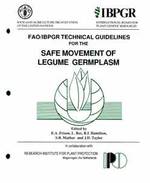 |
FAO / IBPGR Technical Guidelines for the Safe Movement of Legume Germplasm: A methodological model for ecogeographic surveys of crops (0.3MB)
These guidelines are divided into 2 parts. The first makes general recommendations on how best to move grain and fodder legume germplasm and breeding material. The second part covers the important viral, bacterial and fungal diseases of quarantine concern. The information given on any particular pathogen concentrates on those aspects most relevant to quarantine. An appendix lists Latin and vernacular (English, French, Spanish, German and other) names of major legume species. (Abstract © CAB ABSTRACTS, CAB International)
Authors: Frison, E.A.; Bos, L.; Hamilton, R.I.; Mathur, S.B.; Taylor, J.D. (eds.)
Publication Year: 1990
Pages: 88
ISBN-10: 92-9043-150-4
ISBN-13: 978-92-9043-150-3
Language: English
In vitro conservation and cryopreservation manuals
Refinement and standardization of storage procedures for clonal crops
The World Bank-funded Global Public Goods Phase II Project (GPG2) administered by the System Wide Genetic Resources Programme (SGRP) successfully promoted collective actions for the conservation of genetic resources held in the genebanks of the Consultative Group for Plant Genetic Resources (CGIAR). The remit of GPG2 is to increase the security, quality and risk management of genebanks through the development of best practices, validated methodologies and risk management procedures. As appropriate GPG2 outcomes support third party accreditation. Among the collective actions, collaborative activity: “Refinement and standardization of storage procedures for clonal crops” was given to the CGIAR’s In Vitro Genebanks, represented by the Clonal Crop Task Force (CCTF) composed of genetic resources research staff from the four centres: Bioversity International, CIAT, CIP and IITA. These hold the in trust collections of Musa, cassava, potato, sweetpotato, yam and Andean root and tuber crops (ARTCs). The overarching aims of this activity were to:
(1) review the status of vitro conservation in the context of the GPG2 project with an emphasis on the mandated clonal crops;
(2) survey the facilities, storage protocols and practices of CGIAR’s clonal crop genebanks;
(3) collate and review this information with a view to developing quality and risk management systems to support the production and validation of multi-crop best practice guidelines. Outputs from this activity are designated as a three part ‘trilogy’:
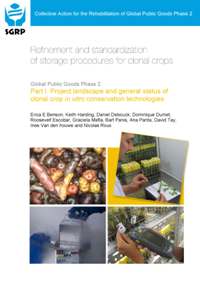 |
Part I, Project landscape and general status of clonal crop in vitro conservation technologies, introduces the GPG2 project within the CGIAR landscape and overviews the status of in vitro plant conservation in the wider conservation community of practice. This part describes the role of risk and quality management for the effective maintenance of in vitro genebanks in the context of research and the development and validation of best practices.
Authors: Erica E Benson, Keith Harding, Daniel Debouck, Dominique Dumet, Roosevelt Escobar, Graciela Mafla, Bart Panis, Ana Panta, David Tay, Ines Van den Houwe and Nicolas Roux
Reviewed by: Sarah E Ashmore and Barbara M Reed
Publication Year: 2011
Pages: 82
ISBN: 978-92-9043-905-9
Language: English
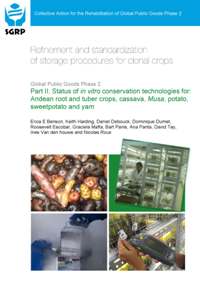 |
Part II, Status of in vitro conservation technologies for Andean root and tuber crops, cassava, Musa, potato, sweetpotato and yam, provides a status update on the mandate clonal crops. As tasked by GPG2, it includes lessons learnt, critical point analyses and the priority research needs of CGIAR’s in vitro genebanks.
Authors: Erica E Benson, Keith Harding, Daniel Debouck, Dominique Dumet, Roosevelt Escobar, Graciela Mafla, Bart Panis, Ana Panta, David Tay, Ines Van den Houwe and Nicolas Roux
Reviewed by: Joachim Keller and Florent Engelmann
Publication Year: 2011
Pages: 106
ISBN: 978-92-9043-906-6
Language: English
Please click here for full size PDF (9 MB)
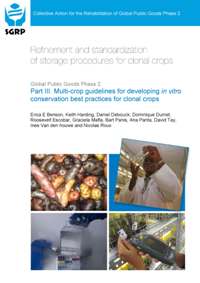 |
Part III, Multi-crop guidelines for developing in vitro conservation best practices for clonal crops, is a compilation of quality and risk management best practices and guidelines from both plant and other bioresources communities. This collective knowledge provided the foundation for developing the GPG2 multi-crop best practice guidelines. They are compiled in two parts. Section I comprises general operational guidelines for quality and risk management in in vitro plant genebanks. Section II provides generic, multi-crop technical guidelines for the medium-term (slow growth) and long-term (cryopreservation) storage of crop germplasm held in in vitro active genebanks (IVAGs) and in vitro base genebanks (IVBGs) respectively.
Authors: Erica E Benson, Keith Harding, Daniel Debouck, Dominique Dumet, Roosevelt Escobar, Graciela Mafla, Bart Panis, Ana Panta, David Tay, Ines Van den Houwe and Nicolas Roux
Reviewed by: David Galsworthy, Florent Engelmann and David Ellis
Publication Year: 2011
Pages: 144
ISBN: 978-92-9043-833-5
Language: English
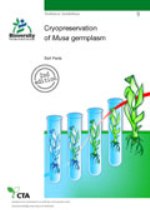 |
Technical Guidelines 9: Cryopreservation of Musa germplasm, 2nd edition (1.3MB)
The aim of this publication is to provide information and guidance on cryopreservation methodologies suitable for use on Musa germplasm. The different methods currently used at Katholieke Universiteit Leuven (KULeuven) for cryopreserving Musa cultures are described as well as the advantages and disadvantages of each of them. The areas where research is still required to further optimize the protocols are also identified. It is hoped that the detailed descriptions of the methodologies will facilitate their adoption and standard use in different laboratories.
Author: Panis, B. Edited by Erica Benson and Florent Engelmann
Publication Year: 2009
Pages: 51
ISBN: 978-2-910810-86-3
Language: English (also available in French and Spanish)
 |
Handbooks for Genebanks No. 7:
Technical guidelines for the management of field and in vitro germplasm collections
Plant species that are vegetatively propagated, that have long life cycles and/or produce nonorthodox seeds are traditionally maintained in field collections. Maintaining plants in the field is costly and carries high risks of loss; therefore, the strategies and procedures employed to establish and maintain field collections need to be practical, rational and economic, in addition to being scientifically sound. Experience in cost-effective management of field collections lies with individual curators and is not readily available to guide others. Further, there are increasing opportunities for using in vitro methods for the conservation of crops normally conserved in the field, and there is a need to develop strategies and procedures for managing in vitro collections as routine and integral part of the overall conservation strategy of a crop or collection.
Authors: Reed, B.M.; Engelmann, F.; Dulloo, M.E.; Engels, J.M.M.
Publication Year: 2004
Pages: 106
ISBN-10: 92-9043-640-9
ISBN-13: 978-92-9043-640-9
Language: English
 |
IPGRI Technical Bulletin No. 7: In vitro collecting techniques for germplasm conservation (0.6MB)
During the early 1980s, while searching for ways to more fully utilize the techniques of plant biotechnology, IPGRI (the International Plant Genetic Resources Institute, then the International Board of Plant Genetic Resources, IBPGR) suggested that germplasm be collected by means of in vitro methods. Between 1990 and today, research in this area has been performed by different groups, leading to the development and/or optimization of in vitro collecting techniques for various additional species including coconut, taro, tropical rainforest tree species and wild and endangered species.
This Technical Bulletin comprises three separate parts. The first part (theoretical background to in vitro collecting), consists of three chapters regarding the rationale behind the development of in vitro collecting and its potential for the conservation of crops and wild or endangered species and the control of contamination, a critically important step which conditions the successful development of any in vitro collecting protocol.
The second part (case studies) comprises nine chapters, each describing the work performed for the development of in vitro protocols for a particular species or group of species. The protocols described can be applied directly for collecting germplasm of any of the species concerned. However, circumstances will differ from one collecting mission to the next and it can be expected that these protocols will have to be adapted to these circumstances. Therefore, the aim of these chapters is to illustrate the range of protocols, from the simplest to the most sophisticated, which can be developed for in vitro collecting germplasm of a given species and to highlight the critical steps of such protocols. Such information should be used by the readers as a guide for the development of protocols for the species of their own interest.
The last part (prospects) consists of a single chapter which analyses the future of in vitro collecting for improving the conservation and use of plant genetic resources.
This Technical Bulletin includes references up to 2001. It includes both theoretical and practical aspects, aims to provide a resource for those wishing to understand the basic concepts of adapting plant tissue culture methods to field collecting.
Authors: Valerie C. Pence, V.C.; Sandoval, J.A.; Villalobos, V.M.; Engelmann, F. (eds.)
Publication Year: 2002
Pages: 100
ISBN-10: 92-9043-534-8
ISBN-13: 978-92-9043-534-1
Language: English
 |
Practical manuals for Handling Crop Germplasm In Vitro 2:
Shoot-tip Culture for the Propagation, Conservation and Exchange of Musa Germplasm (This manual can be purchased via Bioversity's website here)
This publication reviews in detail the history of shoot-tip culture of Musa, in vitro propagation procedures, in vitro conservation, germplasm exchange using in vitro cultures and potential problems.
Authors: Vuylsteke, D.R.
Publication Year: 1989
Pages: 56
ISBN-10: 92-9043-140-7
ISBN-13: 978-92-9043-140-4
Language: English
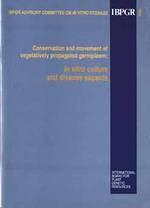 |
IBPGR Advisory Committee on In Vitro Storage: Report of a Subcommittee Meeting: Conservation and Movement of Vegetatively Propagated Germplasm: In Vitro Culture and Disease Aspects (Available in HTML version)
This report examines the problem and reviews the mid-1987 status of some major crops. It looks at the scope available for improvement, for example in in vitro transfer of germplasm and improved indexing, and makes recommendations for future action. Also included are eight reports outlining the status of a number of crops.
Authors: IBPGR
Publication Year: 1988
Pages: 60
ISBN-10: 92-9043-125-3
ISBN-13: 978-92-9043-125-1
Language: English
For more manuals on this topic, please visit the Bioversity International website here.
Seed and seed genebanks
 |
Handbooks for Genebanks No. 1:
The Design of Seed Storage Facilities for Genetic Conservation (3.5 MB)
This is an in-depth report of the factors to be taken into consideration when designing seed storage facilities for genetic conservation. (Revised 1990).
Authors: Cromarty, A.S.; Ellis, R.H.; Roberts, E.H.
Publication Year: 1982
Pages: 100
Language: English
 |
Handbooks for Genebanks No. 2:
Handbook of Seed Technology for Genebanks Vol I: Principles and Methodology
This first volume of seed technology for genebanks deals with many of the principles of seed testing which need to be understood when monitoring the viability of seed accessions maintained in genebanks. It is the second in a general series of genebank handbooks. (Reprinted 1989)
Authors: Ellis, R.H.; Hong, T.D.; Roberts, E.H.
Publication Year: 1985
Pages: 210
ISBN-10: 92-9043-118-0
ISBN-13: 978-92-9043-118-3
Language: English
 |
Handbooks for Genebanks No. 3:
Handbook of Seed Technology for Genebanks Vol II: Compendium of Specific Germination Information and Test Recommendations
This second volume on seed technology for genebanks provides general approaches, detailed information, guidance and, when available, prescriptions for removing dormancy and germinating the seeds. It is the third in a general series of genebank handbooks. (Reprinted 1989)
Authors: Ellis, R.H.; Hong, T.D.; Roberts, E.H.
Publication Year: 1985
Pages: 456
ISBN-10: 92-9043-119-9
ISBN-13: 978-92-9043-119-0
Language: English
 |
Handbook for Genebanks No. 4:
Compendium of Information on Seed Storage Behaviour
A two-volume set providing invaluable information for all concerned with plant genetic resource conservation, seed physiology and seed storage. Information has been collated from over 1200 publications on seed survival during storage for nearly 7,000 species covering 251 families of flowering plants, arranged in alphabetical order for easy reference. A 36 page introduction summarises current understanding of seed physiology as it relates to seed storage.
The introduction on seed physiology can be downloaded at the website of Bioversity International here.
The data on the more than 7000 species can be searched online in Bioversity's Species Compenium database here.
Authors: Hong, T.D.; Linington, S.; Ellis, R.H.
Publication Year: 1998
Pages: 901
ISBN 1-900-37-49-0
Language: English
 |
Handbooks for Genebanks No. 5:
Regeneration of accession in seed collections: a decision guide (4.5 MB)
This decision guide is intended to facilitate the development of optimum procedures for regeneration of seed germplasm. It deals with the timely identification of accessions with inadequate quality or quantity of seed. It also considers the regeneration of those accessions to produce new seed of maximum quality and optimum quantity, with minimum loss of genetic integrity and as cost-effectively as possible. The guide discusses establishment of achievable targets for quality and quantity of seed produced, the maintenance of genetic integrity and minimizing the cost of regeneration. Calculations are based on the requirements of different units of usage - the distribution unit, test unit and base unit - together with a safety factor allowing for losses and a factor allowing for uncertainty of usage. A single case study is presented by way of illustration, and discusses the consequences of the various causes of loss of genetic integrity, by drift, selection and contamination.. The guide aims to provide general considerations on how to improve the effectiveness of germplasm regeneration programmes. The guide includes a poster-size chart outlining the contents of the decision guide in schematic form.
Authors: Sackville Hamilton, N.R.; Chorlton, K.H.
Publication Year: 1997
Pages: 75
ISBN-10: 92-9043-319-1
ISBN-13: 978-92-9043-319-4
Language: English
 |
Handbooks for Genebanks No. 8:
Seed Handling in Genebanks
Genebanks are the storehouses of plant genetic resources, providing the raw material for the improvement of crops. They play a key role in contributing to the sustainable development of agriculture, helping to increase food production and thus to overcome hunger and poverty. Inherent resistance to pests and diseases can be bred into crop plants, reducing the need to use chemicals that can have deleterious effects on farmers and the environment. The seeds contained in genebanks are a vital and irreplaceable resource, a heritage which must be conserved to provide future agricultural options in a world facing climate change and other unforeseen challenges. The sustainable conservation of genetic resources depends on effective actions by genebank staff, who play a critical role in ensuring that germplasm is effectively and efficiently conserved. They need to apply proper procedures for handling seeds to ensure their survival and availability to present and future generations.
The practical manual on Procedures for Handling Seed in Genebanks (Hanson, 1985), published by the International Board for Plant Genetic Resources (IBPGR), a predecessor of Bioversity International, has helped genebank curators and technicians in seed conservation in the past. Research over recent decades has yielded advances in knowledge regarding seed physiology and seed-storage behaviour. The Convention on Biological Diversity (CBD) in 1992, the International Treaty on Plant Genetic Resources for Food and Agriculture (PGRFA) in 2004 and related agreements have changed the global framework of germplasm ownership and benefit-sharing. The development of genetically modified organisms (GMOs) and associated controversies have important implications for the ways genebanks manage their germplasm, notably to prevent the unintentional introgression of exotic genes, including transgenes. All of these new opportunities and challenges called for an update of the 1985 handbook for genebanks.
This manual addresses these recent changes, and is intended to ensure that seed handling in genebanks meets today's requirements. The new manual is complemented by an interactive self-learning module which can be found here. The manual and self-learning module are intended to help address the challenges associated with the shortage and frequent turnover of qualified genebank staff, particularly in developing countries.
With this publication we hope to contribute to ensuring that genebank staff around the world will maintain to high standards of survival and quality the germplasm under their care.
Authors: Rao, N.K.; Hanson, J.; Dulloo, M.E.; Ghosh, K.; Nowell, A.; Larinde, M.
Publication Year: 2006
Pages: 147
ISBN-10: 92-9043-740-5
ISBN-13: 978-92-9043-740-6
Language: English
 |
IPGRI Technical Bulletin No. 1: A protocol to determine seed storage behaviour (0.3 MB)
This publications provides an approach by which conservationists can determine whether or not long-term seed storage is feasible for a particular species, i.e. whether or not that species shows orthodox seed storage behaviour. It provides advice on the implementation of the protocol, examples of ways in which the results from seed storage studies could be misinterpreted due to confounding factors, as well as several alternative approaches for estimating seed storage behaviour prior to carrying out actual investigations with the seeds. In particular, the latter section introduces the concept of a multicriteria approach for estimating seed storage behaviour. It is intended to be used along with the Compendium (see IPGRI Handbooks for Genebanks No.4 - Seed Storage behaviour: a Compendium); these two publications are essentially complementary. The overall aim of the protocol is to guide and encourage further work in this area of seed physiology (particularly for species on which relatively less work has been done to date)m with the objective to expanding on/up-dating the type of species-specific data compiled in the compendium.
Authors: Hong, T.D.; Ellis, R.H.
Publication Year: 1996
Pages: 64
ISBN-10: 92-9043-279-9
ISBN-13: 978-92-9043-279-1
Language: English
 |
IPGRI Technical Bulletin No. 6: Forest tree seed health for germplasm conservation (0.8 MB)
The conservation and use of forest genetic resources worldwide poses several challenges to scientists, policy-makers and, in particular, to local stakeholders interested in long-term strategies to manage these biological resources in a sustainable manner. The vast diversity of tree species, many of which are still unknown, the high level of threats and the increased demand for forest products require prioritization of actions, clear indications for research and development, and strategies to mitigate the current trends in the depletion of forest resources.
The strategy of conservation 'through-use' of forest genetic resources is a very important alternative to an in situ approach and, as such, is to be promoted and developed. However, basic knowledge and understanding of species' reproductive biology, seed production, seed quality and health aspects, limit the use of a larger number of species in important activities such as restoration, rehabilitation, agroforestry and on-farm conservation practices. Increasingly, the use of forest genetic diversity in research and breeding requires a greater movement of germplasm.
This Technical Bulletin, prepared by Drs J. R. Sutherland, M. Diekmann and P. Berjak, all well-known scientists in their respective areas of specialization, aims to breach some of the knowledge gaps in forest seed biology and technology and, more importantly, to contribute to future research on priority forest seed health aspects. In addition, this it aims to increase awareness amongst technical staff involved in conservation and use activities. To this end it presents state-of-the-art tools for the identification of the most important tree seed pathogens and provides clear and ready-touse molecular-based tools for the screening of fungi and virus in seeds.
Authors: Sutherland, J.R.; Diekmann, M.; Berjak, P. (eds.)
Publication Year: 2002
Pages: 85
ISBN-10: 92-9043-515-1
ISBN-13: 978-92-9043-515-0
Language: English
 |
Genebank standards (0.2 MB)
FAO and IBPGR have been cooperating since the early 1970s to strengthen national capabilities in ex situ conservation of plant genetic resources. In 1991, the Commission on Plant Genetic Resources considered it "essential that appropriate standards be developed for genebanks operating within the international Network". The Commission requested the assessment and, if necessary, redefinition of genebank standards. Subsequently, an FAO/IBPGR Expert Consultation was convened in 1992 to discuss and update the Genebank Standards that IBPGR published in 1985. The Genebank Standards recommended by the Expert Consultation were then endorsed by the 5th Session of the Commission on Plant Genetic Resources to be widely utilized as the international reference in national, regional and international genebanks. The Genebank Standards are concerned solely with the storage of seed of orthodox species.
Publication Year: 1994
Pages: 13
ISBN-10: 92-9043-236-5
ISBN-13: 978-92-9043-236-4
Languages: English - Spanish - French - Arabic
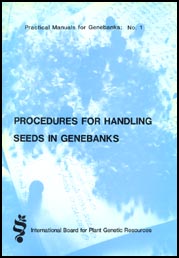 |
Practical manuals for Genebanks No. 1:
Procedures for Handling Seeds in Genebanks
This manual is the first in a series of practical guides to suitable methods for processing and storing seeds in genebanks. It is aimed specifically at informing genebank personnel, especially those technicians and staff involved in day-to-day seed handling. (Reprinted 1988)
Authors: Hanson, J.
Publication Year: 1985
Pages: 115
Language: English
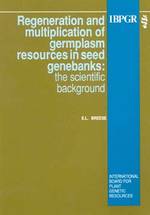 |
Regeneration and Multiplication of Germplasm Resources in Seed Genebanks: The Scientific Background
The regeneration of germplasm resources is an integral part of the conservation programme. This study is directed towards the strategy and tactics of seed regeneration and multiplication by sexual reproduction in relation to problems of maintaining the genetic constitution of the original sampled population.
Author: Breese, E.L.
Publication Year: 1989
Pages: 69
ISBN-10: 92-9043-186-5
ISBN-13: 978-92-9043-186-2
Language: English
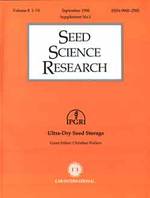 |
Seed Science Research Series: Volume 8 1-74, September 1998, Supplement No. 1 Ultra-Dry Seed Storage, CABI / IPGRI Joint Publication
Seed Science Research provides an international vehicle for the publication or original papers and review articles on the fundamental aspects of seed research. The emphasis is on the physiology, biochemistry, molecular biology and ecology of seeds.
Storage of seed at low temperature is the main ex situ conservation method employed in genebanks. The recommended preferred conditions for long-term seed storage, according to the Genebank Standards published in 1994 by FAO and the International Plant Genetic Resources Institute (IPGRI), are 3-7% seed moisture content, depending on the species, at - 18°C or cooler.
In the late 1980s, systematic research was initiated by the International Board for Plant Genetic Resources (IBPGR, now IPGRI) to investigate the effects of very low moisture content on seed longevity. Much of this research was based on the general assumption that the relative benefit in terms of longevity became greater for each successive reduction in seed moisture content, although this may vary among species. One of the most compelling reasons for undertaking research in this area was the prospect of developing 'low-input' alternatives for medium- to long-term cold storage of seed germplasm through its storage at room temperature (i.e. ultra-dry seed storage). Such an approach, it was believed, would allow for a secure and cost-efficient alternative for seed storage in cases where a reliable supply of electricity is not available for refrigeration of storage rooms. In line with its objectives to develop and broaden the applicability of conservation techniques, IPGRI actively supported research activities in this area, including significant work conducted in research institutes and genebanks in China.
To make appropriate recommendations to the plant genetic resources community, in particular regarding the applicability of the ultra-dry seed technology, it was deemed necessary to resolve the basic questions of the optimal seed moisture level in relation to storage temperature, including the possibility of over-drying the seeds. It was in recognition of this need that IPGRI initiated the global ultra-dry seed storage experiment in 1995. During the Second International Conference on Seed Science and Technology, Guangzhou, China, 12-16 May 1997, a Satellite Symposium on ultra-dry seed storage and longevity was organized by IPGRI to assess the current state of the art in this research area.
Authors: Black, M.; Walters, C.; Cohn, M.A. (eds.)
Publication Year: 1998
Pages: 73
ISBN-10: 0960-2585
Language: English
 |
Proceedings of a Consultation Meeting 4-7 December 1995, ICRISAT, Hyderabad, India: Regeneration of Seed Crops and Their Wild Relatives (1.5 MB)
The ex situ conservation of plant genetic resources is of vital importance to contribute to long-term global food security. Ex situ conservation consists of a series of routine operations and activities, of which many are interlinked, and all of which need proper management. Regeneration of stored germplasm seed samples is one of the key activities as it has a direct bearing on the quality of the material conserved, it requires specific knowledge and expertise and it is usually labour intensive. An average of 50 percent of current national collections are in need of regeneration and urgent action is needed to avoid much of the stored genetic diversity being lost for ever. The deliberations of this meeting resulted in a much better understanding of the complexity of the regeneration process, and generated suggestions and ideas on how to make the process more efficient and cost-effective.
Authors: Engels, J.M.M.; Ramanatha Rao, R. (eds.)
Publication Year: 1998
Pages: 167
ISBN-10: 92-9043-389-2
ISBN-13: 978-92-9043-389-7
Language: English
Wild species conservation
 |
IPGRI Technical Bulletin No. 11: In situ conservation of wild plant species a critical global review of good practices (1.4MB)
The aim of this book is to provide readers with a broad understanding of the concept and methodologies of in situ conservation for target plant species. The book is based upon a global survey, undertaken by the first author, of existing guidelines, methodologies, case studies and other relevant literature on the in situ conservation of plant species, as well as current activities in this area by national and international agencies. This global review was undertaken as part of a UNEP/GEF project (EP/INT/204/GEF) entitled 'Design, Testing and Evaluation of Best Practices for in situ Conservation of Economically Important Wild Species', for which FAO was the executing agency. In preparing the review for publication as a book, we have taken the opportunity to revise the text and add further examples in order to make it suitable for the general reader interested in the subject of in situ conservation of species. We have tried to include examples from as many countries as possible, although much of the work in this area has up until now been undertaken in temperate regions. We have also provided an extensive bibliography which will allow the reader to explore many of the topics covered in the text in more depth.
This book is divided into four parts. Part I deals with the concept, approach and actors of species-based in situ conservation and attempts to clarify the ambiguity of the concept of in situ conservation as it relates to target species. In the minds of many people, in situ conservation is taken to mean the creation of protected areas and implies a narrow ecosystem approach, with the inclusion of local communities and conservation of species being incidental. This concept is now rapidly changing, as more focus is placed on individual target species and the needs and well-being of local communities and people are beginning to receive more consideration. It is also clear that in situ conservation cannot be the sole mode of conservation: it will not be possible to turn the location of every population of wild plants into a protected area, due to cost considerations or other land-use reasons. in situ conservation will need to be complemented by ex situ conservation where appropriate and, in particular, some sites will need to be managed with local stakeholders in a participative manner. Global changes in population growth, land-use patterns and climate change will also affect the ways in which in situ sites are designed and managed (see Section 1.5). This part also discusses the most important international instruments which govern the conservation of wild plant species, notably the Convention on Biological Diversity and the Global Plan of Action, as well as other regional initiatives, and the role of major UN and international agencies dealing with wild species.
Part II of the book focuses on in situ conservation methodologies and describes the various approaches of in situ conservation and the main steps needed for developing a conservation strategy for target species in situ. A number of initial steps are required before in situ conservation sites can be effectively planned and established. These include setting priorities for target species, establishing an information baseline through the carrying out of ecogeographical surveys, and estimating the amount and pattern of genetic diversity. Once this information becomes available, it is possible to prioritize conservation areas for protection and/or management. This part also describes the different types and the role of protected areas in species conservation, and discusses the conservation of species outside protected areas. Of even more importance is the management and monitoring of in situ conservation and populations: this aspect is one of the most neglected in protected areas management, as many protected areas do not have management plans or are not adequately managed, especially for target species. These issues need to be given more prominence by policy-makers.
The global survey of in situ conservation activities is described in Part III. Examples of in situ conservation of various types of taxa, such as threatened species, medicinal and aromatic species, forestry species, crop wild relatives, fruit trees and shrubs, and ornamental and other miscellaneous groups across the world are provided as illustrations of their effective conservation in situ. Detailed information about specific case studies is provided in boxes throughout the text.
Finally, Part IV offers some conclusions and recommendations.
It is hoped that this book will provide managers of protected areas, conservation officers and government officials, as well as all stakeholders involved in in situ conservation, with valuable information and an in-depth understanding of in situ conservation methodologies. It should also be a valuable guide for students of ecology and others engaged in the study of plant genetic resources.
Authors: Heywood, V.H.; Dullo, M.E.
Publication Year: 2005
Pages: 174
ISBN-10: 92-9043-698-0
ISBN-13: 978-92-9043-698-0
Language: English
Molecular genetics and DNA banks
 |
IPGRI Technical Bulletin No. 2: Molecular tools in plant genetic resources conservation: a guide to the technologies (0.2MB)
In October 1995, IPGRI organized a small workshop on the use of molecular techniques in the conservation of plant genetic resources. One area of discussion was the considerable range of different molecular techniques available and the ways in which they could best be used. Deciding on which technique would be most appropriate for particular investigations is not always straightforward and depends on a range of a different factors including the nature of the problem, the biology of the species and the resources available. A number of the experts who participated in the meeting collaborated with IPGRI staff to prepare this publication, which attempts to provide a brief overview of currently available techniques and to outline some of their strengths and limitations. It also provides a framework to assist users in identifying what technique(s) might be most appropriate for their own needs. It is not intended as a laboratory manual of the techniques or as a substitute for the many excellent discussions of the strengths and weaknesses of individual methods that can be found in the literature. Rather, it is a broad survey of the main features of the different techniques and of the factors that conservation workers should bear in mind when initiating a molecular genetic based investigation.
Authors: Karp, A.; Kresovich, S.; Bhat, K.V.; Ayad, W.G.; Hodgkin, T.
Publication Year: 1997
Pages: 47
ISBN-10: 92-9043-323-X
ISBN-13: 978-92-9043-323-1
Language: English
 |
IPGRI Technical Bulletin No. 10: Molecular markers for genebank management (1.6MB)
In the last decade, the use of DNA markers for the study of crop genetic diversity has become routine, and has revolutionized biology. Increasingly, techniques are being developed to more precisely, quickly and cheaply assess genetic variation. These techniques have changed the standard equipment of many labs, and most germplasm scientists are expected to be trained in DNA data generation and interpretation. The rapid growth of new techniques has stimulated this update of IPGRI's Technical Bulletin No. 2, "Molecular tools in plant genetic resources conservation: a guide to the technologies" (Karp et al. 1997b). Our goal is to update DNA techniques from this publication, to show examples of their applications, and to guide genebank researchers towards ways to maximize their use. This bulletin reviews basic qualities of molecular markers, their characteristics, the advantages and disadvantages of their applications, and analytical techniques, and provides some examples of their use.
There is no single molecular approach for many of the problems facing genebank managers, and many techniques complement each other. However, some techniques are clearly more appropriate than others for some specific applications. In an ideal situation, the most appropriate marker(s) can be chosen irrespective of time or funding constraints, but in other cases the choice of marker(s) will depend on constraints of equipment or funds. The purpose of this publication is to explain the characteristics of different markers and guide to their use through a number of real examples that represent well informed choices. What is most important is to choose a marker that can appropriately address well-defined questions through good experimental design, ideally leading to peer-reviewed scientific publications.
Experimental design has many definitions depending on the type of question being asked and on the field of science addressed. We use the term here in a very general way to cover all aspects of planning an experiment, including a clear definition of the question being addressed; knowledge of prior studies addressing the question; proper choice of molecular markers and of data used to address the question; knowledge of the characteristics, strengths and weaknesses of the data; sources of unexpected variation in the data; how much data are needed; proper methods to analyze the data; and limits to conclusions you can make from the results.
One of the most important considerations before beginning any experiment is to address proper experimental design. Improper experimental design can make the work inconclusive, misleading, insignificant, and most likely unpublishable. Similarly, improvements in experimental design can change an uninspired study to a highly significant one with little to no increase in time and funds. Poor experimental design can waste significant resources and damage the reputation and impact of your genebank.
It is beyond the scope of any publication to outline all possible pitfalls that can lead to poorly designed experiments, analyses or conclusions, and different considerations of proper experimental design need to be made in particular fields. This technical bulletin outlines some basic considerations regarding molecular marker types and analyses to lead the reader. There is no substitute, however, for basic knowledge of the biological questions being addressed, knowledge of the taxonomic group under consideration and a thorough literature review to ensure that similar work has not been done before. If limitations of any type hinder genebank and germplasm managers with regards to these factors, collaboration or consultation with experts is well worth the effort.
Excellent reviews of methodology and data interpretation are presented in Weising et al. (1995), Hillis et al. (1996), Staub et al. (1996), Hillis (1997), Karp et al. (1997a,b) and Avise (2004). Hamrick and Godt (1997) present a review of isozyme data; Doebley (1992), Clegg (1993b) and Spooner and Lara-Cabrera (2001) present a review of molecular data for plant genetic resources and crop evolution; Bruford and Wayne (1993), Wang et al. (1994), Gupta et al. (1996), Powell et al. (1996a) and Weising et al. (1998) of microsatellite data; Wolfe and Liston (1998) on Polymerase Chain Reaction (PCR) related data. Schlötterer (2004) reviews the history and relative utility of different molecular marker types. Sytsma and Hahn (1997) present reviews of molecular studies in crop and non-crop plants. Some information from Spooner and Lara-Cabrera (2001) for crop diversity studies was used and updated; Spooner et al. (2003) was used for taxonomy studies.
An overview of the main marker techniques and their comparative qualities is presented in the section titled, "Overview of molecular technologies". Applications of molecular techniques in genebank management and crop breeding are the subject of the following sections. The section titled, "Future challenges" focuses on the current developments in molecular marker applications and future challenges that could result from these developments. Elements of experimental design are discussed throughout and some basic aspects of data analysis are discussed in "Genebank management".
Authors: Spooner, D.; van Treuren, R.; de Vicente, M.C.
Publication Year: 2005
Pages: 126
ISBN-10: 92-9043-684-0
ISBN-13: 978-92-9043-684-3
Language: English
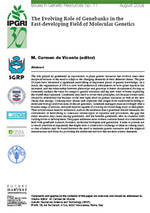 |
Issues in Genetic Resources No. 11, August 2004: The Evolving Role of Genebanks in the Fast-developing Field of Molecular Genetics (0.5MB)
The role played by genebanks as repositories of plant genetic resources has evolved since their inception because of the need to adapt to the changing demands of their different clients. The past 20 years have witnessed a significant unravelling of important pieces of genetic knowledge. As a result, the organization of DNA is now well understood, information on how genes function has increased, and the relationship between phenotype and genotype is better documented, forcing us constantly readjust the value we assign to genetic resources and tap new ways of better exploiting the wealth they represent. Genebanks may need to revise their principles, not because former tasks should be abandoned but because of the new light shed on genetic resources as well as the new clients that emerge. Contemporary clients seek expertise that ranges from traditional breeding to molecular biology and even state-of-the-art genomics. Genebank managers must accordingly offer a broader range of services, and staff must be capable of covering an overarching array of disciplines. Thus several issues must be addressed, such as the attributes that a genebank should maintain, the convenience of networking to outsource certain types of expertise and procedures, the gap this entire situation may create among genebanks, and the benefi ts genebanks offer in countries with varying levels of development. This paper addresses most of these concerns based on a consultation held with genebank curators, breeders, molecular biologists and geneticists. It aims to present not so much solutions as arguments that might steer a constructive exchange of ideas in coming years, so that a balance may be found between the need to maintain genetic resources and the required infrastructure and those for providing the additional services that modern science demands.
Author: Carmen de Vicente, M. (ed.)
Publication Year: 2004
Pages: 54
ISBN-10: 92-9043-623-9
ISBN-13: 978-92-9043-623-2
Language: English
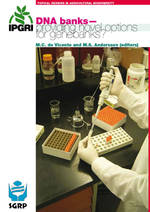 |
DNA banks - providing novel options for genebanks? (0.8MB)
The rapidly expanding study of DNA in so many areas of science has created an odd surplus: the DNA itself. Reasonably easy and inexpensive to store, with established techniques for almost infinite multiplication, the samples of DNA created in laboratories around the world have almost by accident become an important resource for future research. Participants at an IPGRI-organized meeting on The Evolving Role of Genebanks in the Fast-Developing Field of Molecular Genetics (see de Vicente MC, editor. The Evolving Role of Genebanks in the Fast-developing Field of Molecular Genetics. Issues in Genetic Resources No. 11. IPGRI, Rome, Italy; 2004) discussed informally how a more organized and collaborative approach to DNA banking might benefit the conservation and use of genetic resources and other areas of research. Those discussions prompted IPGRI to undertake a worldwide survey, which in turn resulted in this book.
As will be seen from the individual chapters, DNA banking is not at present widespread (fewer than 20% of the institutions responding to a survey bank DNA) but would be welcomed (more than half of the respondents expressed interest in banking DNA). The book also presents considerable evidence of the ways in which DNA banking, by permitting relatively easy transfer and analysis of genetic material, can improve genebank management, plant breeding, conservation, population studies, and many other subjects. Taken together, these suggest that there is indeed a need for practitioners to cooperate to develop the kind of collaborative system envisaged in this book.
Many issues remain to be sorted out. Some are extremely practical: how should DNA banks be physically arranged and should they store both DNA and the tissues from which it was extracted? How should DNA samples be distributed? Others hinge on technical issues: what are the best bioinformatic methods to tie together the various strands of information and the DNA samples from which the information was derived? Yet others involve high-level policy decisions: what rules and procedures will govern the exchange of DNA samples and sequence information, and how will access and benefit sharing, including the benefits of further research on the samples, be governed? By pulling together so many individual experiences and perspectives this book sets out several signposts that will help to guide further discussion and elaboration of DNA banking.
It should be stressed that none of the contributors sees DNA banking as a substitute for the conservation of genetic resources. DNA banks complement conservation strategies that make use of ex situ and in situ conservation, and they can help to ensure the optimal use of plant and animal populations. DNA banks are probably not going to permit the resurrection of extinct populations. But their potential to enhance so many aspects of the use and conservation of genetic resources makes them an important topic for further discussion and elaboration, to which we hope this book will make a useful and distinct contribution.
Authors: de Vicente, M.C.; Andersson, M.S. (eds.)
Publication Year: 2006
Pages: 84
ISBN-10: 92-9043-702-2
ISBN-13: 978-92-9043-702-4
Language: English




